Stamps. The Seventh Island. A Short Philatelic History of Kythera.
BULLETIN OF THE HELLENIC PHILATELIC SOCIETY OF GREAT BRITAIN.
Volume 17. No. 64. Fourth Quarter, 1986. pp.62-67.
[ISSN 0950-3102]
by Damian N Andronicus
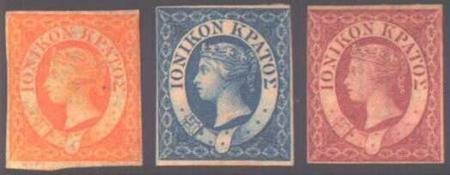
Map 1. The Seventh Island.
Map of the island of Cerigo, the southernmost Ionian Island, Cythera (Greek:Kythera). Copper plate engraved map on a page from atlas of Tomaso Porcacchi, "Isole del Mondo" published in Padua c1585. (Andronicus - 1576, (map creation date(?). Relevant text in Italian below the image. 10x13.7cm (4x5 3/8"). Atlas page measures 33x21cm (11 7/8x 8 1/4").
Of the Ionian Eptanisos the first six islands from Kerkyra to Zakynthos string along the earthquake-prone edge of the Hellenic Trough for about 250 kilometers; but to reach the last island, &ythira, you travel a further 250 km or so in the direction of Cape Malea to. the channel between the Morea and Crete. Kythira is not really an Ionian island nor is it Aegean, situated as, it is on the boundary between the two seas. Being so close to the southern Peloponnese and on many of the old shipping lanes between East and West its strategic importance has been appreciated since early antiquity. Reputed to be the birthplace of both Aphrodite and Helen of Troy, the island was settled at various times by Phoenicians, Minoans and Mycenians before the Greeks arrived: [(VI. 916) (Vl. 1597)] historians from Herodotus to Pausanias all testify to the importance of Kythira. But unprotected as it is, the island has been depopulated several times during its history, and those not killed were taken as slaves. Romans followed Greeks, then caine Byzantines, Venetians, Turks., Venetians again, the French Republic, the Russian Empire, Napoleon’s Empire and finally the British,- who after a half—century occupation ceded the seven Ionian Islands to Greece by treaty in March i864. Kythira’s strategic importance was naturally diminished considerably by the opening in 1895 of the canal at Corinth.
From the Venetian period, .which ended 30 June 1797 when the French Republic took over the seven islands, very few postal items have survived, none so far showing markings other than in manuscript; a future search perhaps in existing Venetian archives may reveal the Most Serene Republic’s official postal arrangements for her Ionian Islands. This first French occupation of Kythira was of short duration, for on ‘6 October 1798, thirty Turkish ships of the line, under the orders of Abdel-Kadir Bey, appeared off Cerigo (the Venetian name for Kythira), and the 'French Department of the Egean Sea' ceased to exist; in consequence of which it is hardly likely that any postal markings from Kytbira from this initial French occupation could have survived.
Following the Russo-Turkish Convention of May 1800 and the formation of the first Septinsular Republic, the postmarks which were so capably dealt with in Bulletins 62 and 63 [Bulletins' of the Hellenic Philatelic Society of Great Britain], were in use for the other six islands, but it is doubtful whether they or any other similar marks were struck on postal items in Kythira-Cerigo during this occupation or the French one which followed shortly: for by the Treaty of Tilsit in 1807 Russia handed the islands back to France. Both occupations being of such short duration for Kythira, there is only one mark attributed to this period: an octagonal-boxed FRANCA (fig.1), doubtless indicating that postage has been paid, the actual amount being written elsewhere on the cover. This mark is recorded on a letter dated May 1854 as well, perhaps showing that the system it represents bridged occupations.
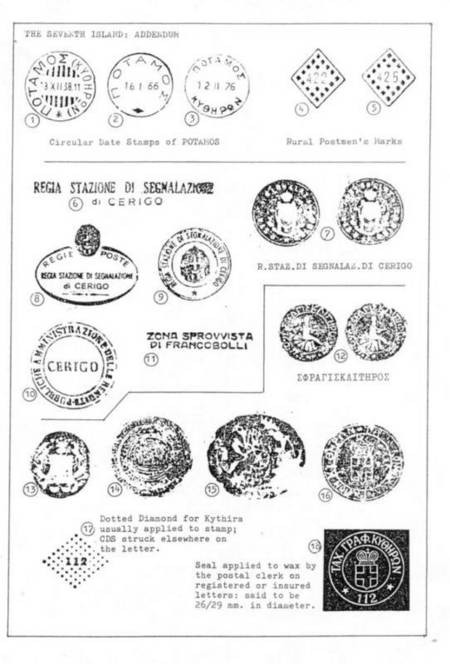
Stamps and postmarks of Kythera. Figures 1-7.
Kythira has a slight connection with the Elgin Marbles, (Vl.1611-15) for on 17 September 1802 the brig ‘Mentor’ with seventeen cases of the Parthenon frieze on board put in at Avlemona to shelter from a westerly gale; but her anchors dragged, and trying to make sail she cut her cables, drifted onto the rocks, was holed and sank in 60 feet offshore. The crew was saved, but two years elapsed before divers from Simi and Kalymnos helped to raise the cases. Finally by the orders of Lord Nelson a transport called on 16 February 1805 and loaded the cases for England. One wonders what could have happened had Russia (then in occupation) seized the opportunity - and the cases - and conveyed this portion of the Parthenon marbles to the Hermitage in Leningrad (St. Petersburg).
It was obvious that Britain resented the return of the islands by the Treaty of Tilsit to France for during the autumn of 1809 and the following spring an expedition sent by Lord Collingwood. recaptured the five southern islands. As the Royal Navy’s history tells it ‘Cerigo fell to Captain Jahleel Brenton of the “Spartan” (a 58-gun frigate) and Major William Clarke of the 35 Regiment, 13 October 1809.’ Brenton was born in America, his father bringing his family to England before the War of Independence.
With British occupation and the subsequent Treaty of Paris in 1815 the Ionian State came into being, and its first postmark. was a 37 m/m diam. double-circle ISOLE * IONIE * (fig.2), the inner circle receiving the postal charge in manuscript. This has not been seen used at Kythira, apparently being confined to Kerkyra and nearby islands. Kythira’s first postmark is recorded on a letter to Lefkas dated 25 June 1819, a large double-circle with ISOLA * DI CERIGO (fig.3), and this remained in use for at least fifteen years, the period being overlapped by the long oval post-mark containing the date, with the name of the island above it in a scroll, all in Italian (fig.4). After centuries of Venetian occupation, Ionian islanders continued the use of Italian with Greek, and some islands had developed a mixed local patois.
The first postal decree for the, Ionian State in 1827 regulated mail charges between the islands by their distance from Kerkyra, the capital, setting the fees due; thus Kythira, being so far away, inevitably came out worst. This distance from the seat of government had its effect in another way, for as John Murray tells it, ‘Cerigo is the “Botany Bay” of the Islands. Convicts are sentenced to different periods of banishment there in proportion to their crimes. It is garrisoned by a company of soldiers and is considered a very solitary station. The’ piratical character of the Maniotes who inhabit ‘the opposite coast of the Morea prevents any free communication with the continent.’
It seems that postal charges in the Ionian Islands were usually prepaid, in contrast to the Greek mainland practise of payment upon delivery. Circulating currency was somewhat mixed: oldi, para, oboli and pence all simultaneously, the last pair perhaps predominating. In 1819 the Ionian State minted three coins in sizes similar to a halfpenny, a penny and, much larger, presumably two-pence; all were copper, as was a fourth of farthing-size minted in 1834, at the same time as a silver coin valued at thirty oboli. All bore the seated figure of Britannia, with a version of the Lion of St Mark on the reverse. No doubt due to the variety of circulating currencies all were undenominated — as were three postage stamps issued in 1859, of which more later.
Authorities vary as to equivalent values; one says ten obols to the penny, another puts the obol value at a halfpenny, a third at a penny. Significantly the first coins of George I, King of the Hellenes, minted in Paris in 1868 include a 5-lepta coin in copper bearing also the value as ΟΒAΛΟΣ: since the drachma was then worth about ten-pence, five lepta would be a halfpenny. By the way, the Parisian engraver of these Greek coins was none other than Albert Barre.
After that of 1827 there were two further postal decrees: in 1845 to provide a general inter-island mail rate ( a matter of some importance for Kythira being so distant from Kerkyra), and a foreign rate; and in 1857 to lower all postal rates and to stipulate prepayment of all postal charges, unpaid mail being taxed double to the adressee. This last decree came into force in December of that year, and remained until transfer of the islands to Greece seven years later; mention was made of three stamps, eventually issued in May 1859.
From about 1835 a 19 m/m diam. double-circle postmark (fig.5) POSTA PAGATA was in use, with tiny variations in design for each island; as usual the inner circle took the amount of prepaid postage hand-written. Later on a similar-sized double-circle date cancellor with Greek letters came into use (fig.6). But the island’s name was grammatically wrong: properly (TA) KΥΦΗΡAΙ KΥΦΗΡA (neuter plural) the & stamp is lettered (AΙ) KΥΦΗΡAΙ (female plural).
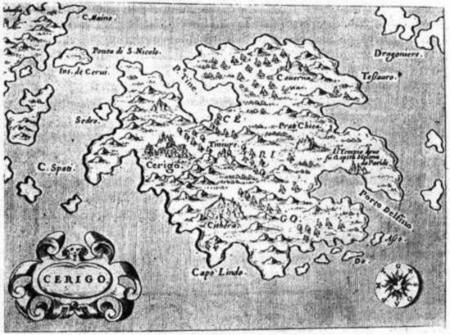
Stamps of the Ionian State. First issued - 1857.
The Ionian State (ΙΟΝΙKΟΝ KΡATΟΣ ) postage stamps (fig.7) which were mentioned in the 1857 decree were reputedly issued on 15 May 1859 (27 May, Gregorian), all three being in the same undenominated design as mentioned above. The blue stamp was printed on paper watermarked ‘2’ but was sold by the post offices at one penny; consequently the carmine stamp (watermark ‘1’) became the 2d value. Sir George F Bowen, Secretary to the Lord High Commissioner of the Ionian Islands, in’ his letter dated 26 May 1858 to his London agent, James Hunter, specified that the first two stamps, Id and 2d, be ‘the same in size, colour, &c as the stamps of the same values used in England, with the exception that the Greek words ΙΟΝΙKΟΝ KΡATΟΣ shall be put round the Queen’s head’, and ordering the stamps on 28 June he wrote ‘1st the paper to be adopted is that with the figure 1 & 2 as a watermark as proposed by Messrs Perkins & Co in their estimate. 2. The Penny stamps are to be red, and the twopenny stamps blue. The denominations (Id & 2d) are not to be placed upon them as the colour will be sufficient distinction’. (vi. 1-3).
In the event, it wasn’t; how the error occurred is a mystery, if it was an error and not a decision-change by the Lord High or his Secretary after completion of printing. In any case no effort seems to have been made to correct it. And soon the departure of Otto gave Britain an opportunity to shed the expensive occupation of an unrewarding territory by a magnanimous gesture by ceding the Islands to Greece upon the election of the brother of Alexandra, Princess of Wales, to the throne of Greece as George I.
The watermarked paper for the stamps was made originally for the stamps of New South Wales, the orange (½d) being printed on unwatermarked paper. The stamps were supplied imperforate, quantities printed being 50,000 of each colour in sheets of 120. But they were unpopular: unused are plentiful, used scarce, on cover rare — especially of Kythira. Cancellation of the stamp was usually by a penstroke across it, the postmark (if any) appearing elsewhere on the cover. Forged postmarks occur — frequently.

Cancelled stamps from the various Ionian Islands. Numbers allotted to the Greek Ionian Islands began with 106 for Kerkyra ending with 112 for Kythira - (far right).
On 21 May 1864 (2 June, Gregorian) the Ionian State became part of the Kingdom of the Greeks, but it was not until 21 December (2 January 1865 Greg.) that new cancellers and the first large heads of Hermes came into use in all the islands.
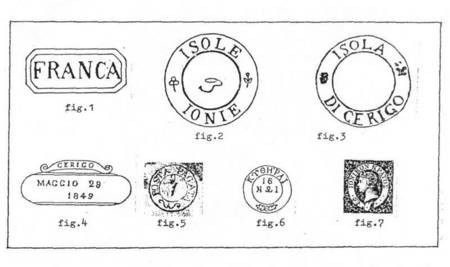
Hermes head stamps. First released 1865.
Cancellers consisted of 21 m/m diam. double-circle date stamps plus the 56-dot lozenges with the postal number of the island in the centre. Numbers allotted to the Greek Ionian Islands began with 106 for Kerkyra ending with 112 for Kythira (fig.8 & 9). Again an error was made in the CDS: the first and second vowels were transposed, and instead of the correct KΥΦΗΡA the name read KΗΦΥΡA; this was later put right in the third CDS type. (Vl.135). The island soon acquired a second post office at the inland town of Potamos, which was allotted number 222. With the arrival of the fourth type of CDS both numbers were removed.
When the administration of the Ionian Islands became Greek, Kythira was detached from the others and attached to the Nomos of Attiki as a district (eparchia); thereafter the island’s affairs, including postal, becoming the responsibility of Piraeus instead of Kerkyra. This ‘gerrymander’ was to have beneficial results in both world wars, Kythira avoiding the sufferings of the other six.
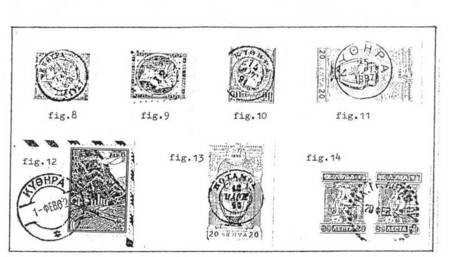
Stamps and postmarks of Kythera.
Figures 8-14.
Circular date stamps of the fifth and sixth types in due course appeared for Kythira, but only type 5 for Potamos and this is very scarce; after which Potamos appears to have relied only on its telegraphic office CDS during the following fifty years or so until it became almost illegible in the 1960s (Figs.10, 11, 12, 13 & 14). In the meantime Kythira’s sixth type was replaced by a 27½ m/m diam. CDS with an interrupted inner circle, (Fig.I5).
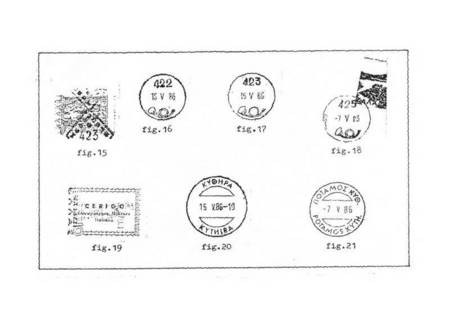
Stamps and postmarks of Kythera.
Figures 15-21.
With an area of about 275 square kilometers Kythira is not small, but its sparse population of less than five thousand is spread over upwards of fifty villages large and small, and the necessity of rural postmen soon became obvious. The more populous lower half of the island contained the synonymous capital (also known as Chora) which became the terminus to two routes, Nos.422 and 423, (fig.16). The other route terminating on Potamos received No.425. The rural post system was established in Greece in 1909 and used cancellers faintly reminiscent of the dotted lozenge, but much cruder, the dots have become large irregular squares and the lozenge enclosed in a heavy outline; the route number is placed in the middle in large sanserif figures. This mark was applied by the postman usually in black, the depot’s CDS being struck elsewhere on the envelope at the terminus.
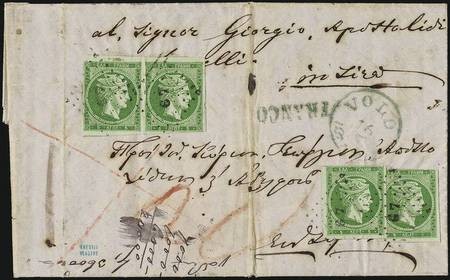
Circular route stamp, and date.
From 1940 onwards a new circular route stamp containing the date was introduced, with the route number above the date and an outline posthorn below. Popularly known as the ‘trotxmbedaki’, Kythera’s three are 21 rn/rn in diameter with the posthàrn turned to the left (fig.17). The depots continued to apply their own larger CDS's on arrival there, Kythira’s being 28 m/m diam., that for Potamos 25 m/m (fig. 18).
An episode of some slight philatelic interest ocoured during the first World War when Royalist and Venizelist factions were contesting for control of Greece. In January 1917 a British Intelligence officer in Venizelist Crete, Lt RNVR J. C. Lawson, promoted an expedition to capture Kythira from the Royalist authorities, his excuse - no doubt fully justified - being that the waters between Crete and the Peloponnese, through which much of the Allied shipping had to pass, were infested with U-boats, and that Kyth±ra was being used as a base. His expedition succeeded without a fight, and although Lawson was ordered by the British government to hand the island back to the Royalists, he discovered that some Kythirians bad emigrated to Australia and returned with British passports, upon which Balf our cancelled his order. In course of time the islanders voted to become a republic, a president was elected, a cabinet formed, ministers appointed, and war declared against Germany. No attempt being made by the Royalists to interfere with this situation, Kytbira remained a ‘republic’ till July 1917 when Constantine abdicated, Alexander became king and Venizelos prime minister, and the island’s allegiance returned to the Kingdom of the Greeks. Compton Mackenzie in Aegean Memories and Lawson himself in Tales of Aegean Intrigue tell slightly different versions of this episode; the philatelic point is that from January to July 1917 the island’s postmarks are not Greece but reflect the Republic of Kytbira. Is it possible that Kythira is still at war with Germany?
In 1956 when Metaxas assumed dictatorial powers he managed to remove gradually many opposition leaders from Athens by an old Greek method, exile to remote islands: George (father of Andreas) Papandreou suffered such a fate, being exiled to Kythira. (Vl. 1587). After the entry of Greece into WWII be managed to escape to the Middle East and eventually took a leading part in the Lebanon Charter and the Caserta Agreement, both of great importance for post—war Greece.
Philatelically little occurred in Kythira during the last war; as part of the Nomos of Attika, Greek stamps continued in use and ISOLE JONIE overprinted Italian stamps were never supplied through the island’s post offices. Greek stamps from the 1937 historical and the 1955 air-mail mythological sets were overprinted in black, red or brown CERIGO / Occupazione Militare / Italiane in three lines (fig.19) but they are bogus and probably produced for propaganda purposes; the majority have the fascist emblem printed on the gum.
With the end of the occupation and the arrival of more peaceful days, gradually tourism took over, as in the rest of Greece; but the discovery of Kythira by the Europeans has been slow in coming, hardly in sufficient numbers to spoil the island, it being out of the beaten track. In common with Greece in general, postmarks have become neater, clearer and bi—lingual, after a short period when only Greek was used (fig.20).
This account does not claim to be complete. I realise that a great deal of further research needs to be done, and this can only be the start to be augmented gradually. Kythira is only one island of Greece’s many, each of them possessing a philatelic history. Perhaps on your next holiday you may be tempted to look at local history from the angle of philately.
Bibliography
Aegean Memories, B Compton Mackenzie, Chatto&Windus, 1940
Aegean, The, H N Denham, Murray, 1963
Apple of Discord, C N Woodhouse, Hutchinson, 1948
Exiles in the Aegean, Bert Birtles, Gollanz, 1938
Greek Dilemma, The, William Hardy McNeill, Gollanz, 1947
Handbook for Travellers in the Ionian Islands, Murray, 184O
Histories, The, Herodotus, Penguin, 1954
History of My Times, Xenophon, Penguin, 1966
History of the Peloponnesian War, Thucydides, Penguin, 1954
History of the Republic of the Ionian Islands, H Jervis White, 1852
Ionian Islands under British Protection, The, James Ridgway, 1851
Making of Modern Greece, The, D A Zakynthos
Michel Catalogue, West Europe, 1973
Perkins Bacon Records, Royal Philatelic Society, 1953
Postmarks & ‘Postage Paid’ Cachets of the Ionian Islands, P J Drossos & A G Argyropoulos, Stamp Collecting, Mar.1935
Postmarks of the Ionian Islands of the Pre—adhesive Period, J Zervos, Philotelia, Oct.1952
Pylarinos Catalogue, 1977
Royal Navy, The, a History, Vol.V, William Laird, Clowes
Royal Navy Biography, Vol.11, John Marshall, 1824
Ships of the Royal Navy, Vol.1, J Colledge
Short History of Modern Greece, A, Richard Clogg
Stamps & Postmarks of the Ionian Islands, 19th Century, The, Jere Hess Barr, FRPSL, Billigs Philatelic Handbook, Vol.IV
Stamps of the Ionian Islands, Yhe, Fred Melville, Stamp Lover, Au&1925
Standard Postage Stamp Catalogue, Vol.11, Scott, 1974
Tales of Aegean Intrigue, J C Lawson, Lt RNVR, Arnold, 1920
Travellers Guide to Corfu & the Other Ionian Islands, Martin Young, Jonathan Cape, 1977
Views in the Ionian Islands, etc, Edward Lear, 1863
Vlastos Catalogue, 1987
Dictionary of National Biography, ed Sir Leslie & Sir Sidney Lee
Stanley Gibbons Balkans Catalogue, Part 3, 1980
Senfs Katalog, 1943—44
BULLETIN OF THE HELLENIC PHILATELIC SOCIETY OF GREAT BRITAIN.
Volume 18. No. 66. Second Quarter, 1987. [ISSN 0950-3102].
THE SEVENTH ISLAND: ADDENDUM
by Damian N. Andronicus.
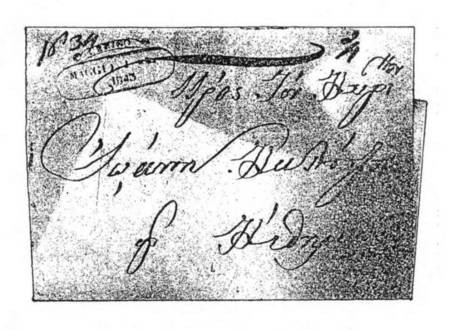
An article with so many gaps inevitably provoked correspondence; unexpectedly all cotiiments were positive.
First came an informative letter from Mr. Alexander Galinos (who is at present engaged on a study of the French military presence in the Balkans during the period 1915—23, as reflected in philately) with which were enclosed two photocopies:
a. three postmarks for the inland town of Potamos (figs.1-3) covering the forty—year period between 1937 and 1976, and two missing rural marks for Routes 422 and 425; and
b. a charming letter-card from World War I - the Chief Engineer of a French patrol—boat, the “Chrysantheme”, searching for U-Boats in the Elafonisos Channel between Kythira and Cape Maleas, writes to his fiancee back in Valence. On the address side is a clear strike of the large
MARINE FRANCAISE * 'SERVICE A LA MER'.
Mr.Pantelis J.Drossos sent a kind letter with a photocopy of strikes from handstamps discovered in the Museum of Kythira, which may remind one of the Rhodes “bag in the basement” referred to in Stamps of Italy used Abroad by Tchilinghirian & Bernardelli, and sets us wondering how many similar marks and strikes lie undetected awaiting discovery in the cellars and storerooms of local museums everywhere.
Among the marks on this photocopy are several (figs.6—9) from a Section of the Italian Army Signals on the island during World War 2, no doubt looking for submarines - British this time. There is a circular strike (fig.10) noting the presence of an administrator for the collection of rents or taxes, and another rubber stamp (fig.11) covers the possibility of a postage-stamp shortage. There are signs of wear on this last strike; all these have been referred to our Colleagues of the Italy and Colonies Study Circle for their comments, which are awaited with great interest.
Some of the other marks may go back as far as the Ionian State (figs.13-16) and include the early Greek dotted diamond with the figures 112 in the centre (fig.17.) At least three of them defy deciphering from the photocopy, and one (fig.12) - with an intriguing figure which may be intended for Aphrodite — bears the legend ΣΦΡAΓΙΣKΛΙTΗΡΟΣ (? Custodian of the Seals?)
Finally, our weary Reader’s attention is drawn to page 258 of Philotelia, the issue for September-October 1986, to an article by Mr.N.Vasdekis entitled “Unknown Postmarks”; among the illustrations is one (fig.18) of a circular seal which was applied to hot wax used by the postal clerk when accepting postal packets for registration or insurance. These seals are said to have been supplied to all the Greek numbered post—offices:
the one illustarted is lettered POST OFFICE OF KYTHIRA * 112 *. It will be understood that in opening the letter or packet the recipient would inevitably destroy the wax seal.
Comment from W.G.Moseley.
Referring to figure 10, I have amongst my Ionian Island documents a piece of an account, unfortunately undated, but probably from the mid-eighteenth century, a mark of the Public Accounts Administration as this figure is, but with the word ‘CORFU’ across the centre instead of ‘CERIGO’ as shown. Is it possible that the same mark could have been used with the name of the other islands as well?